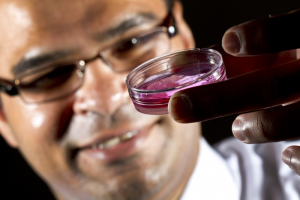Ravi Birla, associate professor of biomedical engineering with the University of Houston Cullen College of Engineering, is one of the world’s leading researchers in the development of bioartificial hearts and heart components. Through this work, heart transplant waiting lists may one day be a thing of the past. Instead, patients at essentially any point in their care could receive bioartificial hearts grown in a lab.
For his research, Birla’s home country of Trinidad and Tobago has recognized him with one of its most prestigious awards for medical researchers.
The country’s National Institute of Higher Education, Research, Science and Technology (NIHERST) will present Birla with The Emmanuel Ciprian Amoroso Award for Medical Sciences at a ceremony scheduled for Nov. 23. The honor is part of NIHERST’s Awards for Excellence in Science & Technology program, which is designed to recognize the nation’s most accomplished scientific researchers.
“I’ve very happy and a bit taken aback by it, actually,” said Birla. “I’m from there and grew up there so to be recognized at the highest level by your home country is definitely an honor; it doesn’t compare to anything else.”
Birla’s research, which is supported by a National Institutes of Health R01 Grant (the NIH's oldest and most prestigious funding mechanism), includes developing artificial heart muscle and parts of hearts, like ventricles and biological pumps. The star of his research portfolio, however, is the whole heart project, which is focused on developing full bioartificial hearts.
This research, he said, has three main components: bioartificial heart muscle; “scaffolding” that will offer the physical shape and form of a heart for the artificial muscle to pump; and bioreactors, devices Birla is developing that train bioartificial heart tissues to behave like natural tissue.
To create bioartificial heart muscle, Birla takes cells from animal models and using a novel platform developed in his lab, allows these cells to reorganize and form artificial heart muscle.
He then uses bioreactors to condition this tissue (along with other bioartificial tissues) to behave like native heart muscle. The bioreactor teaches the cells in the tissue to pump strongly and in unison. Sensors built into these systems allow Birla to measure the properties of these tissues without damaging them – a major improvement over other measurement methods that result in the destruction of the tissue.
Next comes the scaffolding. “To create a complete bioartificial heart, you need more than just tissue,” said Birla. “You need something that will provide the actual physical structure of a heart. That’s the role of scaffolding.”
Instead of trying to engineer scaffolding that matches the heart’s complex form, Birla relies on organs from animal models. These are placed in a series of chemical solutions that completely break down and remove all cells and cellular components from the organ. What’s left behind is an extra-cellular matrix of proteins and other materials that provides the heart’s exact shape.
With complete scaffolding, the challenge becomes getting healthy cells into that tissue. Birla is exploring two alternatives for cell delivery: expose the scaffolding to a cell population, which will allow the engineered cardiac cells to slowly enter the organ on their own, or wrap the scaffolding in a patch of artificial heart muscle that will deliver cells to the matrix.
No matter how cells are delivered, a patch of artificial heart muscle is then wrapped around the scaffolding – not to deliver cells, but to actually pump the heart. “The scaffolding provides the form of the heart while the patch provides the contractile, pumping action” said Birla.
With this approach, Birla has developed full, functioning bioartificial hearts using animal models. Much work must be done, however, before the technology can be transferred to humans – an advance that Birla estimates is still several years away. In the mean time, the tissues and heart components he is developing –valves, vessels, ventricles, muscles, et cetera – could begin saving lives much sooner.
“You can look at an artificial heart as the Holy Grail. That’s 20 years out, but it’s not the only solution a patient can benefit from,” he said. “Heart disease is progressive. We want to replace current treatments with biological alternatives that are grown in the lab. That alone could save many, many lives.”
